2022 TOYOTA COROLLA tire size
[x] Cancel search: tire sizePage 481 of 678
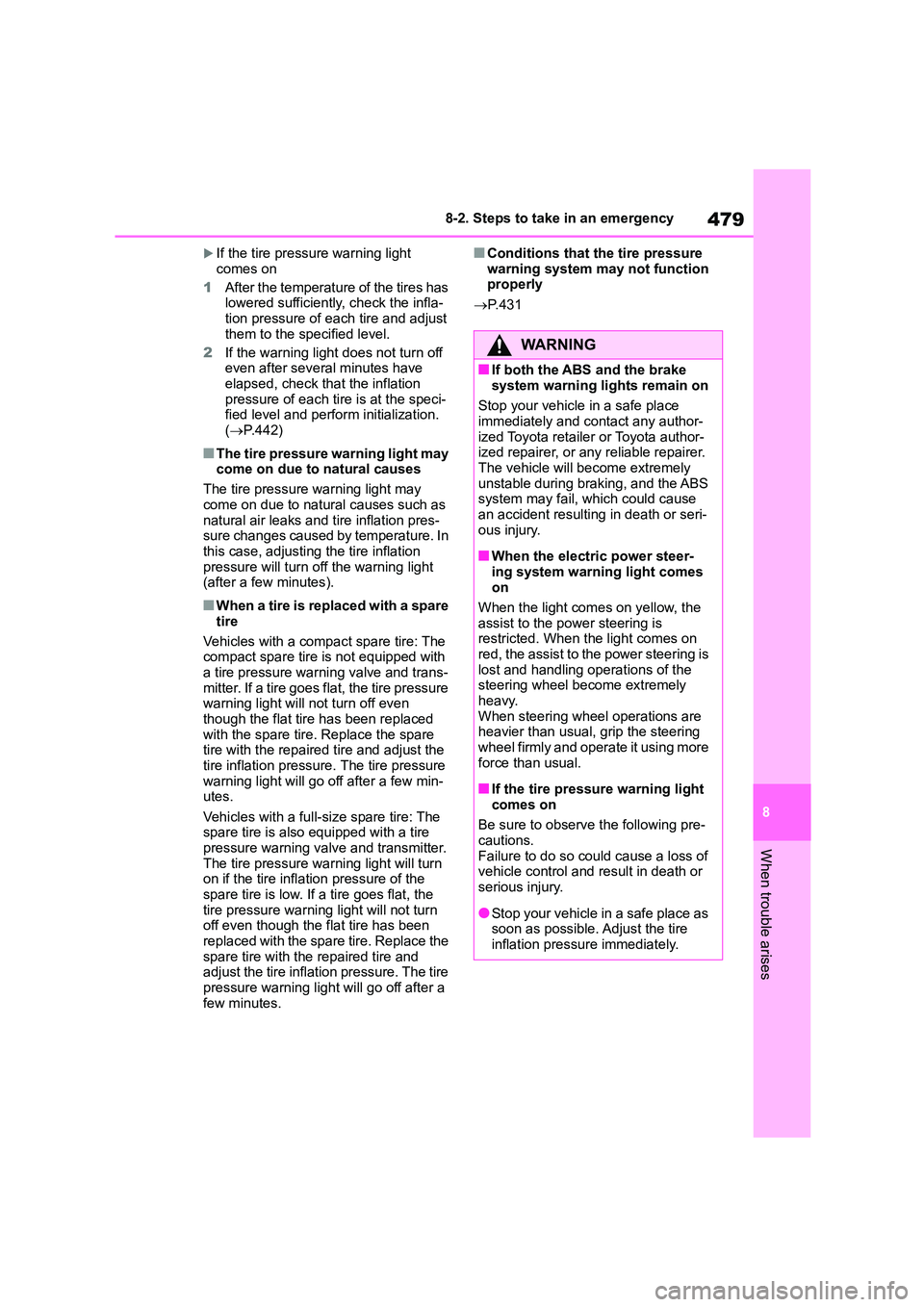
479
8
8-2. Steps to take in an emergency
When trouble arises
If the tire pressure warning light
comes on
1 After the temperature of the tires has lowered sufficiently, check the infla-
tion pressure of each tire and adjust
them to the specified level.
2 If the warning light does not turn off even after several minutes have
elapsed, check that the inflation
pressure of each tire is at the speci- fied level and perform initialization.
( P.442)
■The tire pressure warning light may
come on due to natural causes
The tire pressure warning light may
come on due to natural causes such as
natural air leaks and tire inflation pres- sure changes caused by temperature. In
this case, adjusting the tire inflation
pressure will turn off the warning light (after a few minutes).
■When a tire is replaced with a spare
tire
Vehicles with a compact spare tire: The compact spare tire is not equipped with
a tire pressure warning valve and trans-
mitter. If a tire goes flat, the tire pressure warning light will not turn off even
though the flat tire has been replaced
with the spare tire. Replace the spare tire with the repaired tire and adjust the
tire inflation pressure. The tire pressure
warning light will go off after a few min- utes.
Vehicles with a full-size spare tire: The
spare tire is also equipped with a tire pressure warning valve and transmitter.
The tire pressure warning light will turn
on if the tire inflation pressure of the spare tire is low. If a tire goes flat, the
tire pressure warning light will not turn
off even though the flat tire has been
replaced with the spare tire. Replace the spare tire with the repaired tire and
adjust the tire inflation pressure. The tire
pressure warning light will go off after a few minutes.
■Conditions that th e tire pressure
warning system may not function properly
P. 4 3 1
WA R N I N G
■If both the ABS and the brake system warning lights remain on
Stop your vehicle in a safe place
immediately and contact any author-
ized Toyota retailer or Toyota author- ized repairer, or any reliable repairer.
The vehicle will become extremely
unstable during br aking, and the ABS system may fail, which could cause
an accident resulting in death or seri-
ous injury.
■When the electric power steer-
ing system warning light comes on
When the light comes on yellow, the
assist to the power steering is restricted. When th e light comes on
red, the assist to the power steering is
lost and handling operations of the steering wheel become extremely
heavy.
When steering wheel operations are heavier than usual, grip the steering
wheel firmly and operate it using more
force than usual.
■If the tire pressure warning light
comes on
Be sure to observe the following pre-
cautions.
Failure to do so could cause a loss of vehicle control and re sult in death or
serious injury.
●Stop your vehicle in a safe place as
soon as possible. Adjust the tire
inflation pressure immediately.
Page 487 of 678
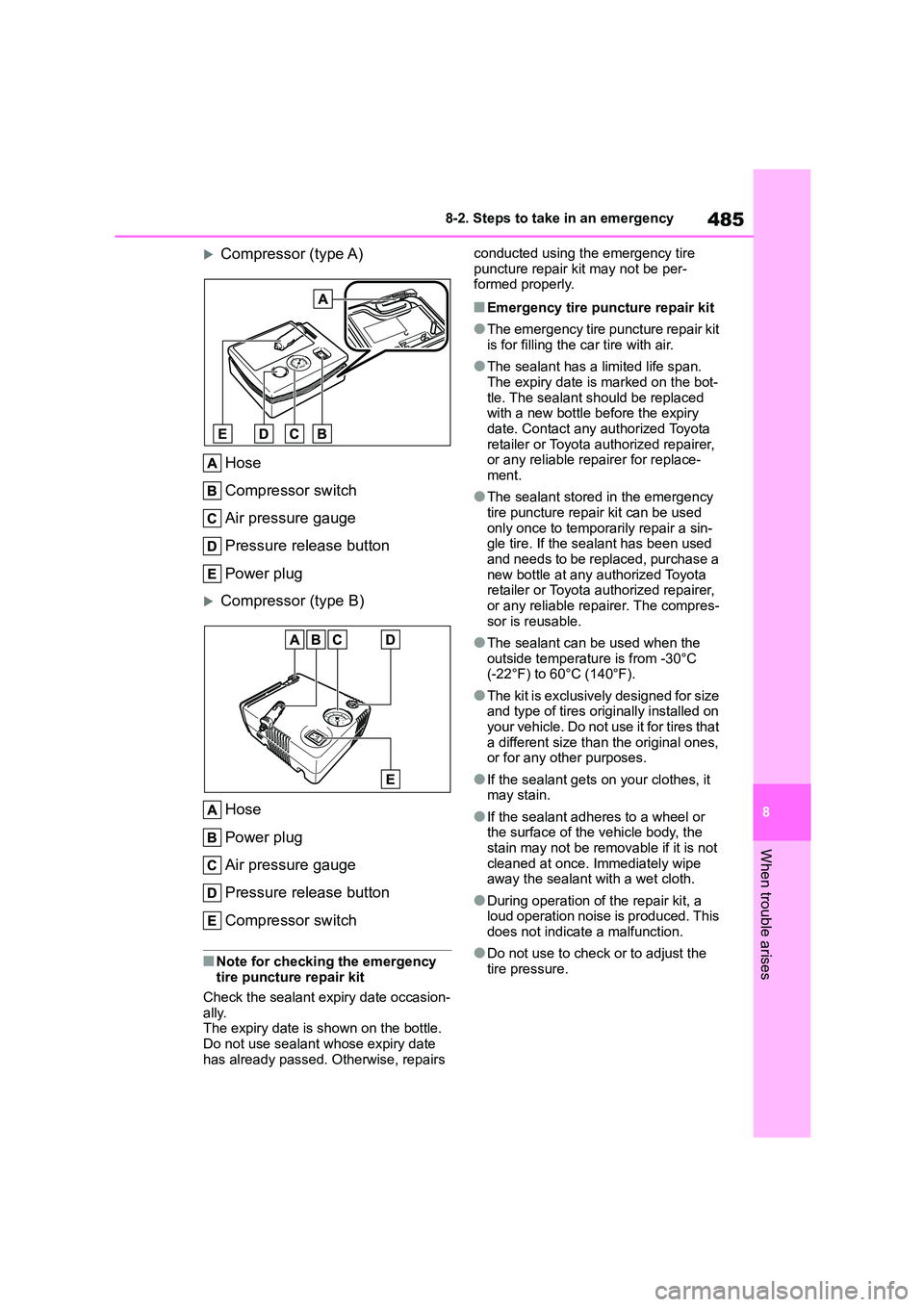
485
8
8-2. Steps to take in an emergency
When trouble arises
Compressor (type A)
Hose
Compressor switch
Air pressure gauge
Pressure release button
Power plug
Compressor (type B)
Hose
Power plug
Air pressure gauge
Pressure release button
Compressor switch
■Note for checking the emergency tire puncture repair kit
Check the sealant expiry date occasion-
ally. The expiry date is shown on the bottle.
Do not use sealant whose expiry date
has already passed. Otherwise, repairs
conducted using the emergency tire
puncture repair kit may not be per- formed properly.
■Emergency tire puncture repair kit
●The emergency tire puncture repair kit is for filling the car tire with air.
●The sealant has a limited life span. The expiry date is marked on the bot-
tle. The sealant should be replaced
with a new bottle before the expiry date. Contact any authorized Toyota
retailer or Toyota authorized repairer,
or any reliable repairer for replace- ment.
●The sealant stored in the emergency tire puncture repair kit can be used
only once to temporarily repair a sin-
gle tire. If the sealant has been used and needs to be replaced, purchase a
new bottle at any authorized Toyota
retailer or Toyota authorized repairer, or any reliable repairer. The compres-
sor is reusable.
●The sealant can be used when the
outside temperature is from -30°C
(-22°F) to 60°C (140°F).
●The kit is exclusively designed for size
and type of tires originally installed on your vehicle. Do not use it for tires that
a different size than the original ones,
or for any other purposes.
●If the sealant gets on your clothes, it
may stain.
●If the sealant adheres to a wheel or
the surface of the vehicle body, the stain may not be removable if it is not
cleaned at once. Immediately wipe
away the sealant with a wet cloth.
●During operation of the repair kit, a
loud operation noise is produced. This
does not indicate a malfunction.
●Do not use to check or to adjust the
tire pressure.
Page 488 of 678
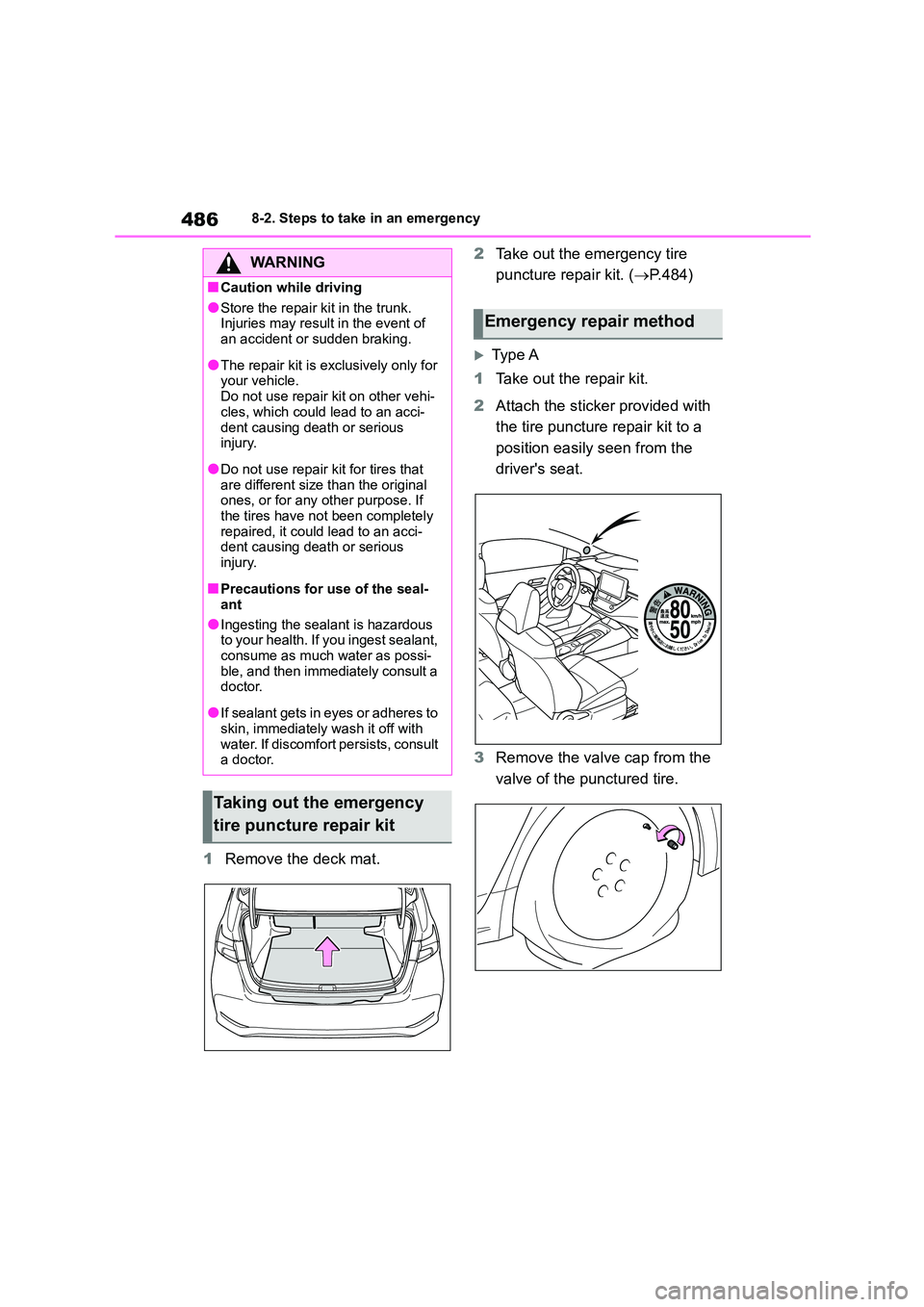
4868-2. Steps to take in an emergency
1Remove the deck mat.
2 Take out the emergency tire
puncture repair kit. ( P.484)
Ty p e A
1 Take out the repair kit.
2 Attach the sticker provided with
the tire puncture repair kit to a
position easily seen from the
driver's seat.
3 Remove the valve cap from the
valve of the punctured tire.
WA R N I N G
■Caution while driving
●Store the repair kit in the trunk.
Injuries may result in the event of an accident or sudden braking.
●The repair kit is exclusively only for your vehicle.
Do not use repair kit on other vehi-
cles, which could lead to an acci-
dent causing death or serious injury.
●Do not use repair kit for tires that are different size than the original
ones, or for any other purpose. If
the tires have not been completely repaired, it could lead to an acci-
dent causing death or serious
injury.
■Precautions for use of the seal-
ant
●Ingesting the sealant is hazardous
to your health. If you ingest sealant,
consume as much water as possi- ble, and then immediately consult a
doctor.
●If sealant gets in eyes or adheres to
skin, immediately wash it off with
water. If discomfort persists, consult a doctor.
Taking out the emergency
tire puncture repair kit
Emergency repair method
Page 502 of 678
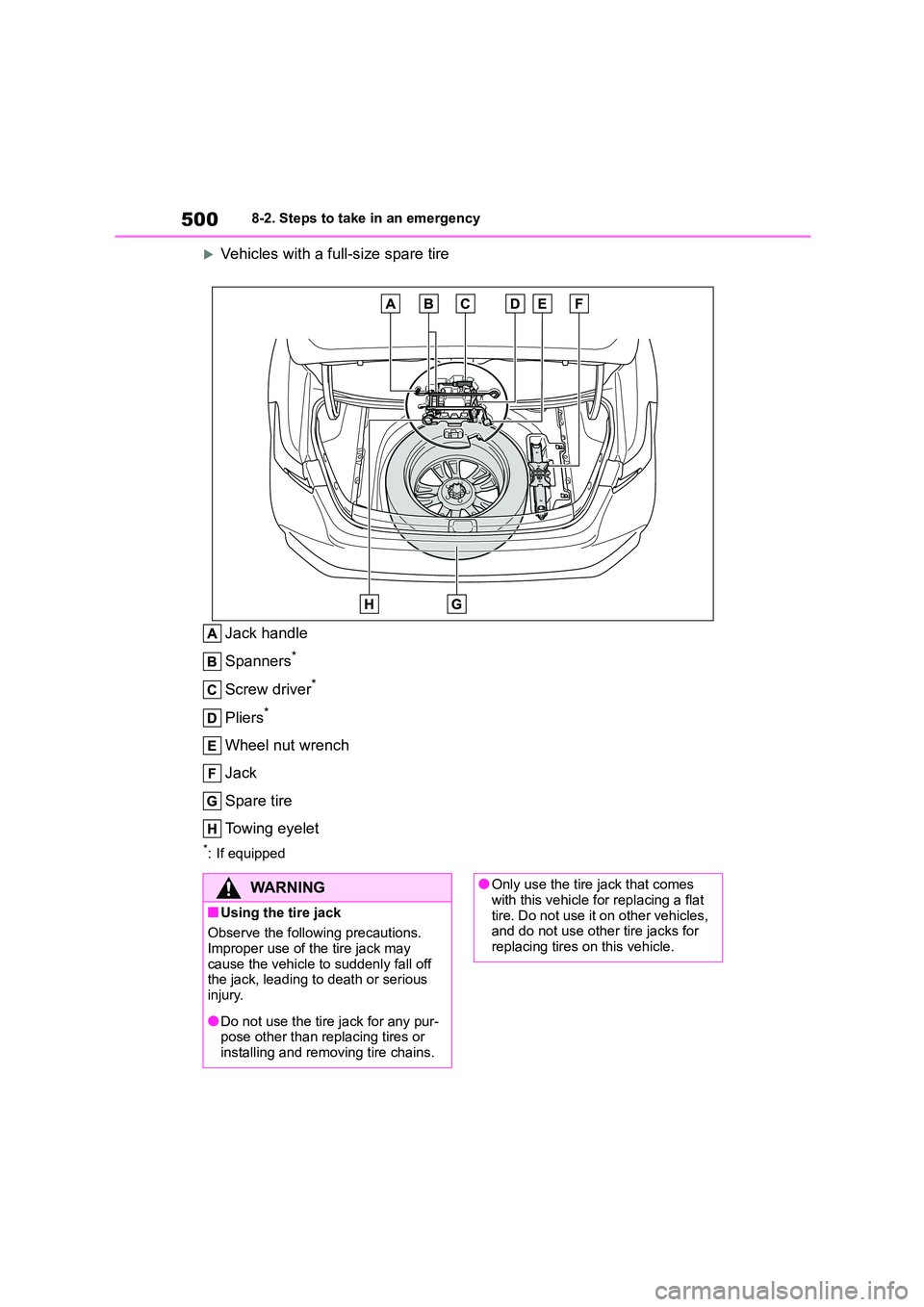
5008-2. Steps to take in an emergency
Vehicles with a full-size spare tire
Jack handle
Spanners*
Screw driver*
Pliers*
Wheel nut wrench
Jack
Spare tire
Towing eyelet
*: If equipped
WA R N I N G
■Using the tire jack
Observe the following precautions.
Improper use of the tire jack may
cause the vehicle to suddenly fall off the jack, leading to death or serious
injury.
●Do not use the tire jack for any pur-
pose other than replacing tires or
installing and removing tire chains.
●Only use the tire jack that comes with this vehicle for replacing a flat
tire. Do not use it on other vehicles,
and do not use other tire jacks for replacing tires on this vehicle.
Page 503 of 678
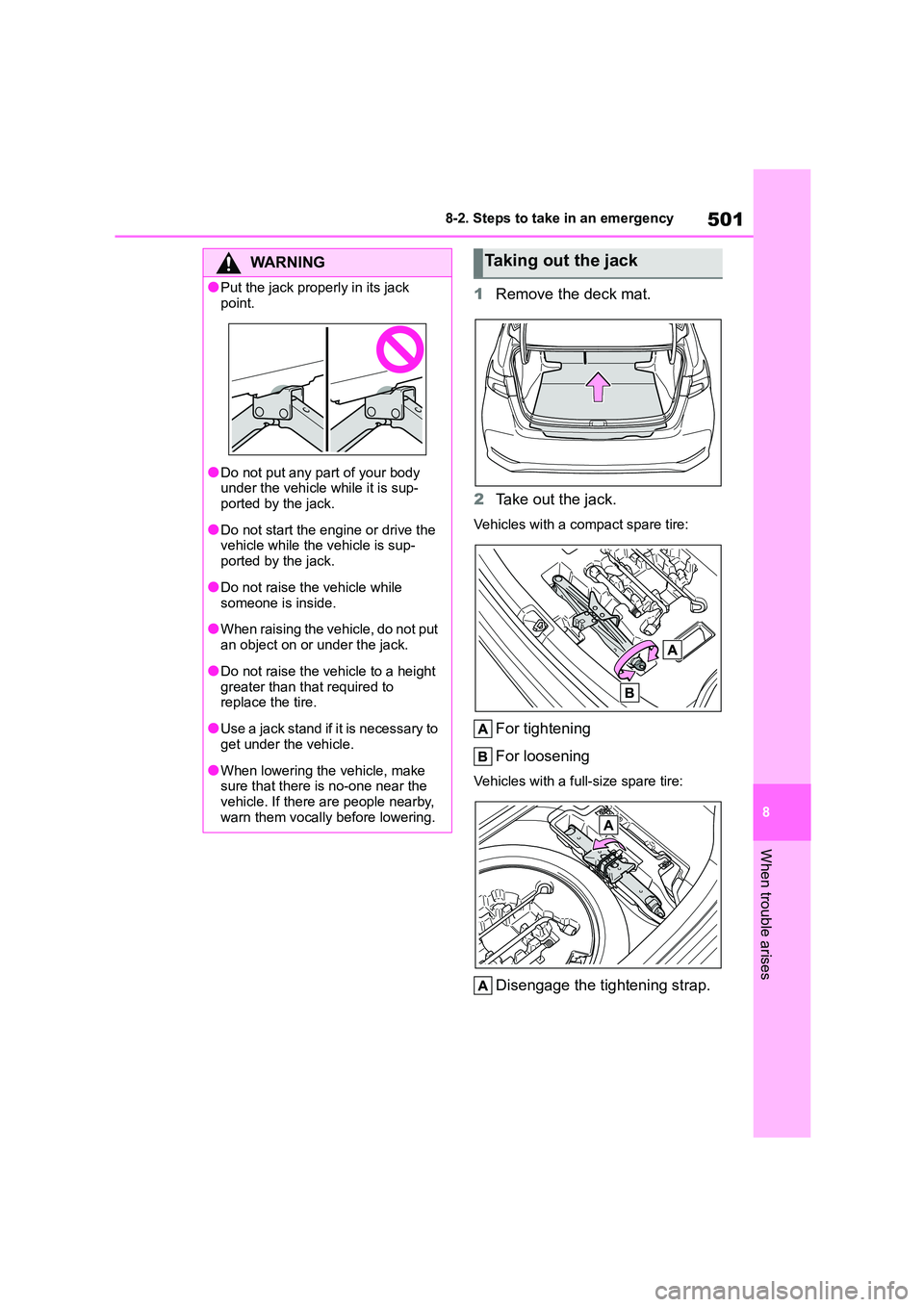
501
8
8-2. Steps to take in an emergency
When trouble arises
1 Remove the deck mat.
2 Take out the jack.
Vehicles with a compact spare tire:
For tightening
For loosening
Vehicles with a full-size spare tire:
Disengage the tightening strap.
WA R N I N G
●Put the jack properly in its jack
point.
●Do not put any part of your body under the vehicle while it is sup-
ported by the jack.
●Do not start the engine or drive the
vehicle while the vehicle is sup-
ported by the jack.
●Do not raise the vehicle while
someone is inside.
●When raising the vehicle, do not put
an object on or under the jack.
●Do not raise the vehicle to a height
greater than that required to replace the tire.
●Use a jack stand if it is necessary to get under the vehicle.
●When lowering the vehicle, make sure that there is no-one near the
vehicle. If there are people nearby,
warn them vocally before lowering.
Taking out the jack
Page 504 of 678
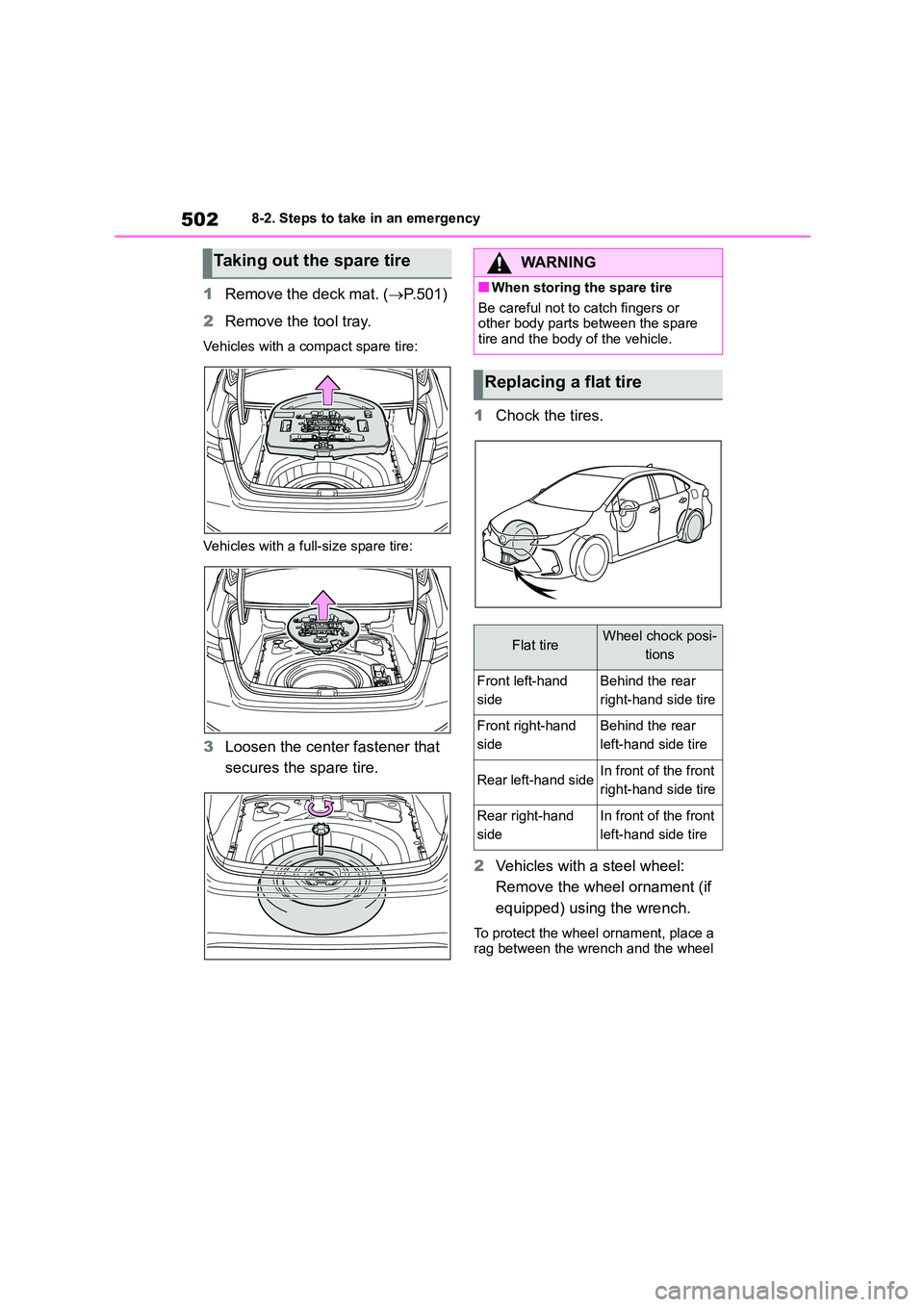
5028-2. Steps to take in an emergency
1Remove the deck mat. (P.501)
2 Remove the tool tray.
Vehicles with a compact spare tire:
Vehicles with a full-size spare tire:
3 Loosen the center fastener that
secures the spare tire.
1 Chock the tires.
2 Vehicles with a steel wheel:
Remove the wheel ornament (if
equipped) using the wrench.
To protect the wheel ornament, place a
rag between the wrench and the wheel
Taking out the spare tireWA R N I N G
■When storing the spare tire
Be careful not to catch fingers or
other body parts between the spare tire and the body of the vehicle.
Replacing a flat tire
Flat tireWheel chock posi-
tions
Front left-hand
side
Behind the rear
right-hand side tire
Front right-hand
side
Behind the rear
left-hand side tire
Rear left-hand sideIn front of the front
right-hand side tire
Rear right-hand
side
In front of the front
left-hand side tire
Page 507 of 678
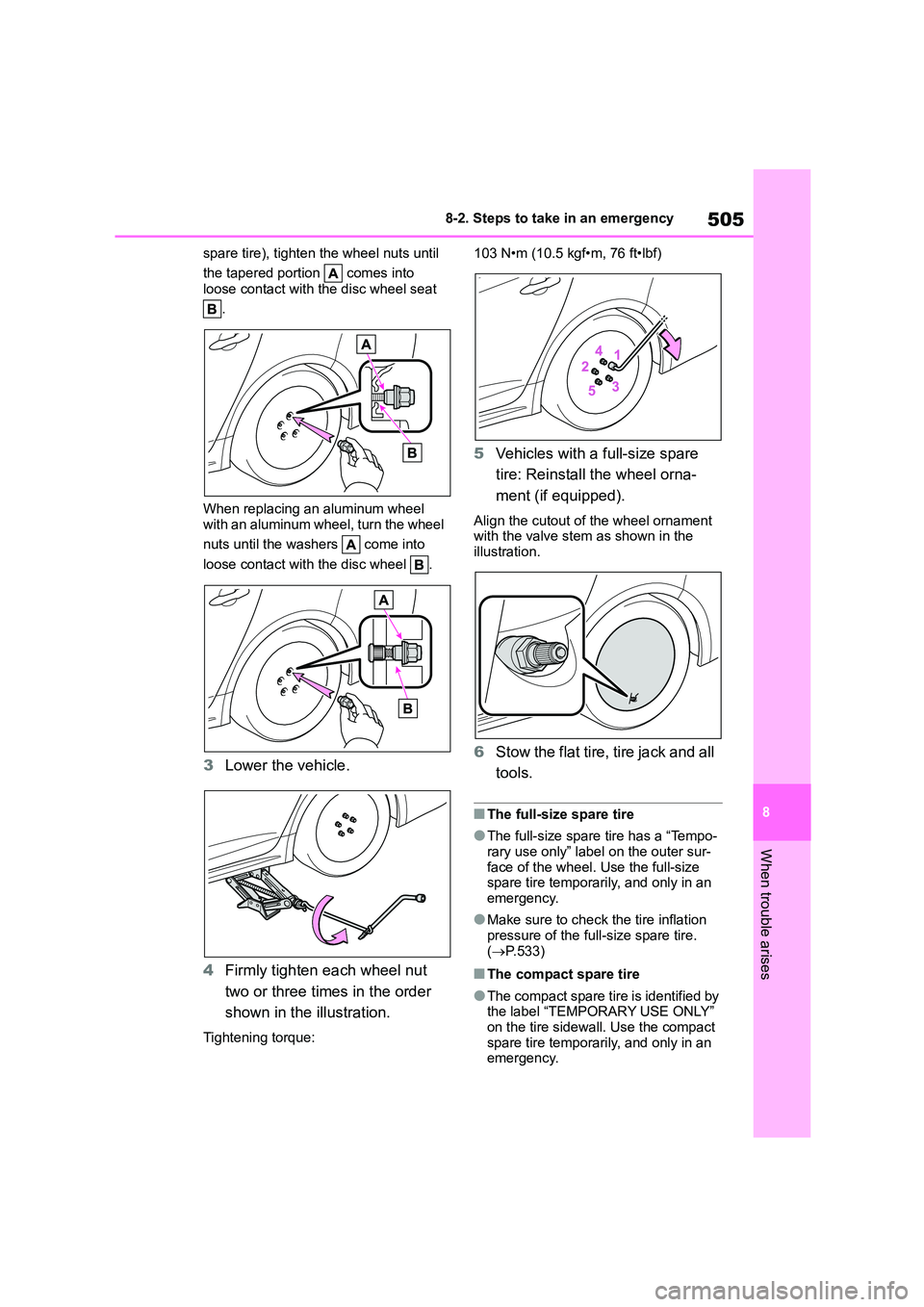
505
8
8-2. Steps to take in an emergency
When trouble arises
spare tire), tighten the wheel nuts until
the tapered portion comes into
loose contact with the disc wheel seat
.
When replacing an aluminum wheel
with an aluminum wheel, turn the wheel
nuts until the washers come into
loose contact with the disc wheel .
3 Lower the vehicle.
4 Firmly tighten each wheel nut
two or three times in the order
shown in the illustration.
Tightening torque:
103 N•m (10.5 kgf•m, 76 ft•lbf)
5 Vehicles with a full-size spare
tire: Reinstall the wheel orna-
ment (if equipped).
Align the cutout of the wheel ornament
with the valve stem as shown in the
illustration.
6 Stow the flat tire, tire jack and all
tools.
■The full-size spare tire
●The full-size spare tire has a “Tempo-
rary use only” label on the outer sur-
face of the wheel. Use the full-size spare tire temporarily, and only in an
emergency.
●Make sure to check the tire inflation
pressure of the full-size spare tire.
( P.533)
■The compact spare tire
●The compact spare tire is identified by
the label “TEMPORARY USE ONLY” on the tire sidewall. Use the compact
spare tire temporarily, and only in an
emergency.
Page 510 of 678

5088-2. Steps to take in an emergency
WA R N I N G
■When using the full-size spare
tire
●Replace the full-size spare tire with a standard tire as soon as possible.
●Avoid sudden acceleration, abrupt steering, sudden braking and shift-
ing operations that cause sudden
engine braking.
■When using the compact spare
tire
●Remember that the compact spare tire provided is specifically
designed for use with your vehicle.
Do not use your compact spare tire on another vehicle.
●Do not use more than one compact spare tires simultaneously.
●Replace the compact spare tire with a standard tire as soon as possible.
●Avoid sudden acceleration, abrupt steering, sudden braking and shift-
ing operations that cause sudden
engine braking.
■When the compact spare tire is
attached
The vehicle speed may not be cor-
rectly detected, an d the following sys-
tems may not operate correctly:
• ABS & Brake assist
• VSC
•TRC
• Automatic High Beam (if equipped)
• Cruise control (if equipped)
• Dynamic radar cruise control with full-speed range (if equipped)
• Dynamic radar cruise control (if equipped)
• EPS
• PCS (Pre-Collision System) (if equipped)
• LDA (Lane Departure Alert with steering control) (if equipped)
• LTA (Lane Tracing Assist) (if equipped)
• Tire pressure warning system
• Toyota parking assist-sensor (if
equipped)
• PKSB (Parking Support Brake) (if
equipped)
• BSM (Blind Spot Monitor) (if
equipped)
• Rear view monitor system (if
equipped)
• S-IPA (Simple Intelligent Parking
Assist System) (if equipped)
• Navigation system (if equipped)
■Speed limit when using the com-
pact spare tire
Do not drive at speeds in excess of 80 km/h (50 mph) when a compact spare
tire is installed on the vehicle.
The compact spare tire is not
designed for driving at high speeds.
Failure to observe this precaution may lead to an accident causing
death or serious injury.
■After using the tools and jack
Before driving, make sure all the tools
and jack are securely in place in their storage location to reduce the possi-
bility of personal injury during a colli-
sion or sudden braking.